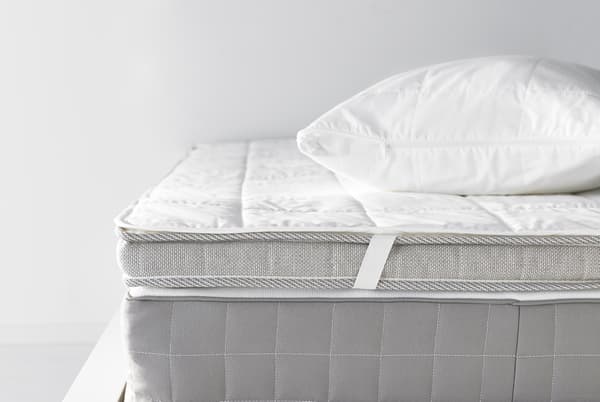Take care of your furniture
We want to help you live more sustainably at home. Nowadays, 4% of the solid waste that ends up at the rubbish dump is furniture. Together we can provide a better future for used furniture. We all deserve a second chance! Discover the solutions we offer to extend the life of IKEA products.
How to clean and care for your mattress
Add a protective cover to your mattress: this will be easier to take off and wash, keeping your mattress as good as new. In addition, most of our mattresses come with washable ticking. Check that the zip is closed before washing.
To remove dust and mites, vacuum your mattress clean.
How to wash the pillow and quilt
Quilts and pillows which are packed rolled up can become compressed whilst being transported, and may take a few days to regain their shape and springiness.
Feathers and down have a characteristic odour which disappears once the quilt has been unpacked and aired for a while. Mites thrive in warm, damp, dark environments. So when you get out of bed, air your quilt, duvet or pillow so that the residual moisture can evaporate before you put the quilt or pillow back on the bed.
In addition, all IKEA quilts and pillows are washable at 60ºC, a temperature that kills off mites.
To keep your quilts/pillows in pristine condition, and free from mites and dirt, follow the washing instructions. To help your quilt/pillow regain its springiness and dry more quickly after washing, put a few colour-fast tennis balls in the drum of the tumble dryer. When washing a feather or down quilt, only use a third of your usual amount of detergent. After washing your quilt, put it to dry immediately. Air your quilt/pillow frequently to keep it in perfect condition. To prolong the life of pillows, use a protective cover to guard against dirt and stains.
Keeping your pots and pans as good as new
Before using your pan for the first time, wash it, rinse it and dry it carefully.
Check that your pan is dishwasher-compatible. To prevent water stains, dry it thoroughly with a cloth after washing. Stains can be removed using a little vinegar dissolved in warm water.
To prevent salt stains, do not add salt until the water is boiling.
Do not use a metal scouring sponge or anything that could scratch the surface.
The base of the pan is slightly concave when the pan is cold, but expands to become level when it is heated. Always let your pans cool before washing them. This allows the base to regain its shape, and helps to prevent any distortion through use.
Our pans are suitable for use with all types of hob as well as in the oven.
Our pans have been designed exclusively for cooking, and not for storing ingredients. Ingredients stored in pots and pans for prolonged periods can damage the surface of the pan, or can acquire a metallic taste.
To save energy, use our pans over a hob with a diameter equal to, or smaller than, the pan.
Remember that handles can become very hot when the pans are exposed to heat. Always use oven gloves or something similar to move pans or to remove lids.
Do not allow a pan containing no liquid to remain over the heat, because the pan could lose its shape if exposed to excessive heat.
Towels and cloths
Although it is a matter of choice, it is recommended to wash towels separately from other items, as this prevents their fibres from flattening, ensures they do not absorb dyes from clothing and stops fluff transferring from them onto clothing.
So, in order to save money and energy, wait until you have enough towels needing washing so that you can wash them all together and obtain better results. However, make sure the wash load is not too big, as the towels need to be able to move easily to allow the water to pass between and through them, so that they are left completely clean.
Fabric conditioners reduce the absorbency of towels, but on the other hand, they improve softness and springiness. So what is the answer? Use conditioner every second or third time you wash the towels; this will help to prolong their useful life without sacrificing softness.
As a general recommendation, machine wash towels at 60°C, and do not use bleach. Dry them in the tumble dryer at the normal setting, and iron them with a warm iron.
